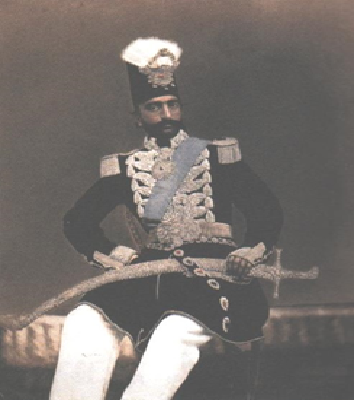Behind his lens of camera, which brought with him from Russia, maybe he was thinking of what the composition is needed for this important photo (I mean here, form of sitting, standing, touching, or being objects or other people, as well as selecting the right background for a photo) and what The gesture should be given to the body and face of the king of Iran.
Of course, he who was trained in photography in his country, finally took up his task and recorded the first Persian photo at the Golestan Palace by the Dagrotayep technique.
Since unfortunately, none evidences has not yet been found or published from this historical photo, we also do not correctly know whether at that historical moment the Shah of Iran was finally lulled and subdued by the magic of the camera and posed as the photographer wanted, or The Shah created a royal pose and gesture of which himself desired like the tradition of his predecessors in the encounter of painters.

Although the Russians, in response to the official request of Mohammad Shah Qajar, had abducted the upper hand from their British and French counterparts, the situation did not continue. Only after a short time, Julius Richard was the second person to come to Iran to respond to King’s request from France. In fact, he can be considered the first European photographer who came to Iran in 1844 (1223 AD) and engaged in photography and training. He later became known as Richard Khan in the period of king Naser-Al-Din-Shah, in addition to teaching photography in the court of Iran, he taught in the field of photography at that time in Dar Al Fonoun (the first European-class higher education school in Iran). Perhaps many of the first portraits of the Iranians who were studying in the Dar Al Fonoun have been taken by Richard Khan during those years.
But in fact, the peak of the flourishing and development of this art-industry in Iran can be attributed to the period of Nasir al-Din Shah Qajar (1848-1848) / (1275-1227AD). Nasseruddin Mirza had been acquainted with photography during his adolescence when he was crown prince. He later became so enthralled and enthusiastic about photography on his long journeys to Europe that he decided to take the camera himself.
The charm of this most advanced technology in that era so tempted the king that during the nearly half century of his monarchy he has recorded more than hundreds of photos of his favorite, wives, interesting subjects, people and even the most private court issues. In order to carry out technical affairs related to the emergence, printing and maintenance of these expensive photos, even he dedicated several special rooms of Golestan Palace to this fascinating skill, named the Akkas-Khane Mobarakeh Houmayoni.
You can read some of reasons why Iranian king has been so seriously and so interesting in photography, pursued in a collection entitled ” THE PHOTOGRAPH AND THE ALBUM” by a group of authors.
It seems that Nasir al-Din Shah, in addition to himself was enjoying of this artistic industry, was aware of the growing importance of this new modernity instrument. So he ordered to encourage and support the foreigner professors to teach photography at the academy due to this increasing importance. It is interesting to know that in the Nasser period, even several books on photography from French and English were translated into Farsi.
Some famous foreign professors teaching photography at the Dar-Al-Funon:
1- August Karl Krziz from Austria
2- Fuketi from Italy
3. Luigi Pesce from Italy
4. Luigi Montabone from Italy
5. Franklin Carlhian from France
The last French teacher (of the list above) was the one who directly taught the photography to the king and taught the first Iranian Photographer Agha Reza Akas Bashi.
As it was reviewed, to get photography to Iran as a souvenir that brought a new product of the modernity of European, was widely welcomed by the king, court and the people.
One of the most important requirements of using this attractive technology was the presence and activity of a significant number of European professors and professional photographers in Iran, although some ones who were interested in photography had begun to train in this field. In this way, not only were the first photographs taken by foreigner photographers, but also they were who used and taught artistic issues, arrangement, gesture, poses, background and the other subjects of photography to their Iranian students for the first time.
Portrait photography in Iran is as old as the photography itself. in the other word, the first and the most photos taken by the arrival of the cameras in Iran in the nineteenth century at the same time as the Qajar dynasty may’ve been portrait.
Indeed, in portrait photography, the subject of photography, which is a human face or body, has a great deal of importance and several factors such as the position of the subject, body shape, facial expression (gesture), other objects in the photo, layout, background, framing, and lighting in the production of a portrait play a significant role.
Undoubtedly, the inner struggle between the subject and the photographer on the formulation of a portrait that began by the first photograph in Golestan Palace did not end there, and whatever this art-industry was more developed and more popular among the court and the people, the formulation of a portrait also found more variety.
So, many scholars believe that the gestures, forms and compositions of European photos, along with this novelty, have entered Iranian images/photos and have become more stable over time. And, in contrast, other scholars have found the presence of Iranians’ long-term illustration traditions among painters and artists as a more effective factor in shaping and portraying portrait of the Qajar era.
- source : Mehrnews






























